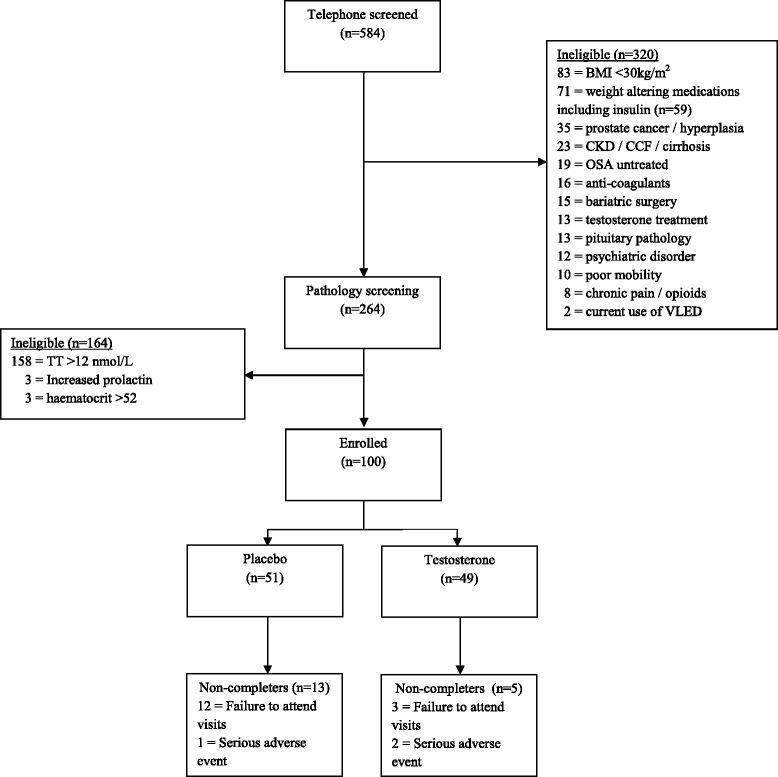Effects of testosterone treatment on body fat and lean mass in obese men on a hypocaloric diet: a randomised controlled trial
- PMID: 27716209
- PMCID: PMC5054608
- DOI: 10.1186/s12916-016-0700-9
Effects of testosterone treatment on body fat and lean mass in obese men on a hypocaloric diet: a randomised controlled trial
Abstract
Background: Whether testosterone treatment has benefits on body composition over and above caloric restriction in men is unknown. We hypothesised that testosterone treatment augments diet-induced loss of fat mass and prevents loss of muscle mass.
Methods: We conducted a randomised double-blind, parallel, placebo controlled trial at a tertiary referral centre. A total of 100 obese men (body mass index ≥ 30 kg/m2) with a total testosterone level of or below 12 nmol/L and a median age of 53 years (interquartile range 47-60) receiving 10 weeks of a very low energy diet (VLED) followed by 46 weeks of weight maintenance were randomly assigned at baseline to 56 weeks of 10-weekly intramuscular testosterone undecanoate (n = 49, cases) or matching placebo (n = 51, controls). The main outcome measures were the between-group difference in fat and lean mass by dual-energy X-ray absorptiometry, and visceral fat area (computed tomography).
Results: A total of 82 men completed the study. At study end, compared to controls, cases had greater reductions in fat mass, with a mean adjusted between-group difference (MAD) of -2.9 kg (-5.7 to -0.2; P = 0.04), and in visceral fat (MAD -2678 mm2; -5180 to -176; P = 0.04). Although both groups lost the same lean mass following VLED (cases -3.9 kg (-5.3 to -2.6); controls -4.8 kg (-6.2 to -3.5), P = 0.36), cases regained lean mass (3.3 kg (1.9 to 4.7), P < 0.001) during weight maintenance, in contrast to controls (0.8 kg (-0.7 to 2.3), P = 0.29) so that, at study end, cases had an attenuated reduction in lean mass compared to controls (MAD 3.4 kg (1.3 to 5.5), P = 0.002).
Conclusions: While dieting men receiving placebo lost both fat and lean mass, the weight loss with testosterone treatment was almost exclusively due to loss of body fat.
Trial registration: clinicaltrials.gov, identifier NCT01616732 , registration date: June 8, 2012.
Keywords: Body composition; Caloric restriction; Obesity; Testosterone.
Figures

References
-
- Tajar A, Forti G, O’Neill TW, Lee DM, Silman AJ, Finn JD, Bartfai G, Boonen S, Casanueva FF, Giwercman A, et al. Characteristics of secondary, primary, and compensated hypogonadism in aging men: evidence from the European Male Ageing Study. J Clin Endocrinol Metab. 2010;95:1810–8. doi: 10.1210/jc.2009-1796. - DOI - PubMed
-
- Bhasin S, Pencina M, Jasuja GK, Travison TG, Coviello A, Orwoll E, Wang PY, Nielson C, Wu F, Tajar A, et al. Reference ranges for testosterone in men generated using liquid chromatography tandem mass spectrometry in a community-based sample of healthy nonobese young men in the Framingham Heart Study and applied to three geographically distinct cohorts. J Clin Endocrinol Metab. 2011;96:2430–9. doi: 10.1210/jc.2010-3012. - DOI - PMC - PubMed
Publication types
MeSH terms
Substances
Associated data
LinkOut - more resources
Full Text Sources
Other Literature Sources
Medical

